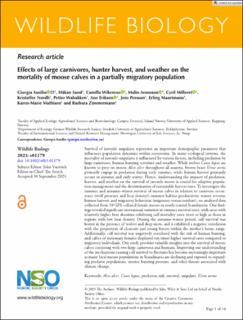| dc.description.abstract | Survival of juvenile ungulates represents an important demographic parameter that influences population dynamics within ecosystems. In many ecological systems, the mortality of juvenile ungulates is influenced by various factors, including predation by large carnivores, human hunting activities and weather. While wolves Canis lupus are known to prey on moose Alces alces throughout all seasons, brown bears Ursus arctos primarily engage in predation during early summer, while human harvest primarily occurs in autumn and early winter. Hence, understanding the impacts of predation, harvest, and weather on the survival of juvenile moose is crucial for adaptive population management and the determination of sustainable harvest rates. To investigate the summer and autumn–winter survival of moose calves in relation to carnivore occurrence (wolf presence and bear density), summer habitat productivity, winter severity, human harvest, and migratory behaviour (migratory versus resident), we analysed data collected from 39 GPS-collared female moose in south-central Scandinavia. Our findings revealed significant interannual variation in summer survival rates, with areas with relatively higher bear densities exhibiting calf mortality rates twice as high as those in regions with low bear density. During the autumn–winter period, calf survival was lowest in the presence of wolves and deep snow, and it exhibited a negative correlation with the proportion of clearcuts and young forests within the mother's home range. Additionally, calf survival was negatively correlated with the risk of human hunting, and calves of stationary females displayed ten times higher survival rates compared to migratory individuals. Our study provides valuable insights into the survival of moose calves coexisting with two large carnivores and humans. Improving our understanding of the mechanisms causing calf survival to fluctuate has become increasingly important as many local moose populations in Scandinavia are declining and exposed to expanding predator populations, intense hunting pressure, and other threats associated with climate change. | en_US |

